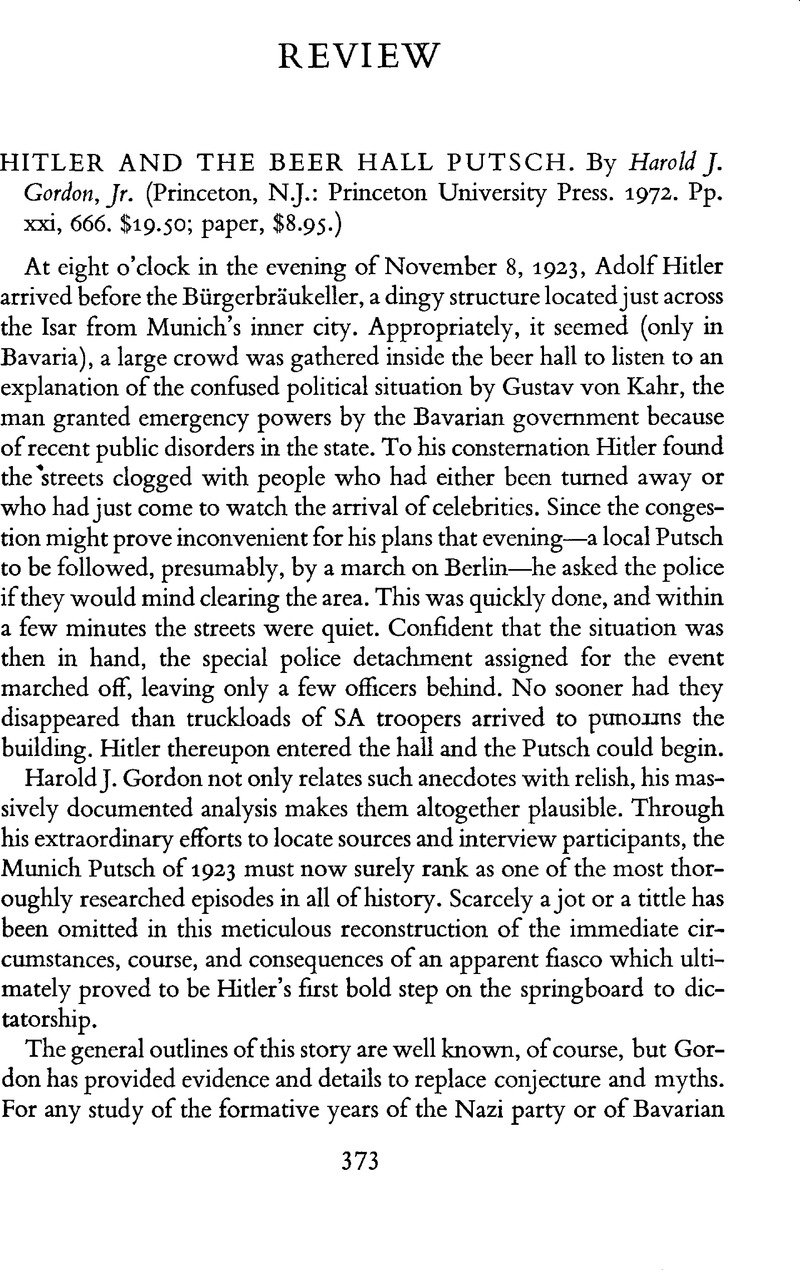No CrossRef data available.
Article contents
HITLER AND THE BEER HALL PUTSCH. By Harold J. GordonJr. (Princeton, N.J.: Princeton University Press. 1972. Pp. xxi, 666. $19.50; paper, $8.95.)
Published online by Cambridge University Press: 16 December 2008
Abstract

- Type
- Review
- Information
- Copyright
- Copyright © Conference Group for Central European History of the American Historical Association 1973
References
1. Barraclough, Geoffrey, “Mandarins and Nazis,” “The Liberals and German History,” “A New View of German History,” New York Review of Books, Oct. 19, Nov. 2, Nov. 16, 1972.Google Scholar
2. Holborn, Hajo, A History of Modern Germany, 1840–1945 (New York, 1969);Google ScholarBracher, Karl Dietrich, Die deutsche Diktatur (Cologne and Berlin, 1969),Google Scholar translated as The German Dictatorship (New York, 1970).Google Scholar
3. Childs, David, Germany since 1918 (New York, 1971).Google Scholar
4. Holborn, Hajo, ed., Republic to Reich: The Making of the Nazi Revolution (New York, 1972).Google Scholar
5. Stern, Fritz, The Failure of Illiberalism (New York, 1972).Google Scholar It is indicative of Barra- clough's quandary that a passage quoted by him as an “endorsement of the position of the younger generation,” and as marking “a decisive stage” in the attack on liberal historiography, was actually first published nearly a decade ago in an introduction by Stern to another anthology, The Path to Dictatorship (New York, 1966), among whose contributors was Bracher.Google Scholar
6. Loewenberg, Peter, “The Psychohistorical Origins of the Nazi Youth Cohort,” American Historical Review, vol. 76, no. 5 (12 1971), 1457–1502.CrossRefGoogle ScholarPubMed
7. Nolte, Ernst, Der Faschismus in seiner Epoche (Munich, 1963),Google Scholar translated as Three Faces of Fascism (New York, 1966). Gordon does not cite Nolte's other writings on the subject.Google Scholar
8. Gordon, Harold J. Jr., The Reichswehr and the German Republic, 1919–1926 (Princeton, 1957).Google Scholar
9. Bosl, Karl et al. , Bayern in Umbruch (Munich, 1969).CrossRefGoogle Scholar
10. Albrecht, Willy, Landtag und Regierung in Bayern am Vorabend der Revolution von 1918 (Berlin, 1968);Google ScholarAy, Karl-Ludwig, Die Entstehung einer Revolution (Berlin, 1968);Google ScholarFenske, Hans, Konservatismus und Rechtsradikalismus in Bayern nach 1918 (Berlin and Zurich, 1969).Google Scholar
11. Bullock, Alan, Hitler. A Study in Tyranny, rev. ed. (New York, 1964).Google Scholar
12. Among others: Moses, Solomon, Demosthenes, Alexander the Great, the Gracchi, Nero, Mohammed, Peter the Hermit, Genghis Khan, Robert Bruce, Edward IV and the Earl of Warwick, Ferdinand of Aragon, Savonarola, Machiavelli, Paul Revere, Marie Antoinette, Sieyès, Robespierre, Napoleon I, Louis Philippe, Thoreau, Napoleon III, Boulanger, Churchill, Stalin, Tojo, Castro, Mao Tse-tung, George Wallace and Curtis Lemay.
13. At a recent conference held by the New School for Social Research in New York, the “Weimar analogy” was debated by a hundred or more specialists in German history. A number of papers delivered at the conference are collected in Social Research, vol. 39, no. 2 (Summer 1972).Google Scholar




